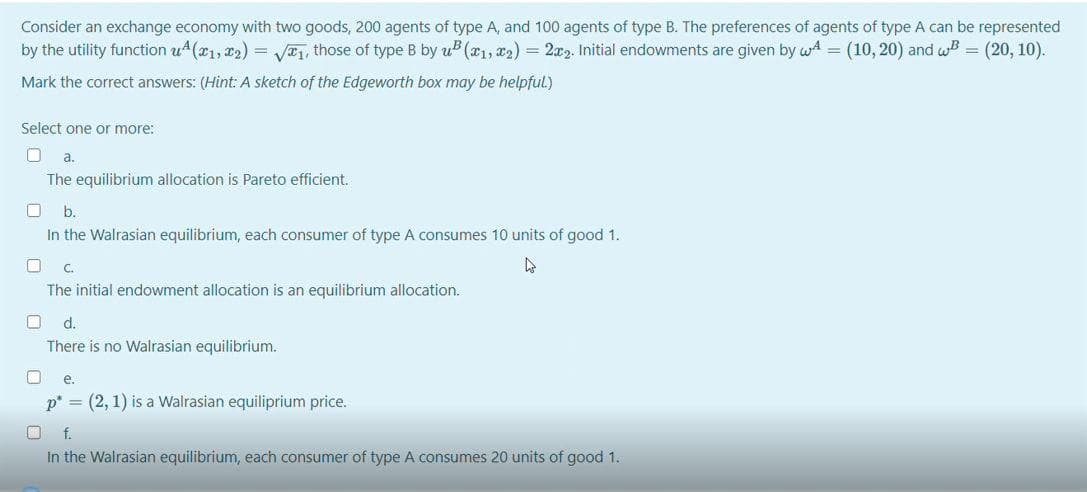Consider an exchange economy with two goods, 200 agents of type A, and 100 agents of type B. The preferences of agents of type A can be represented by the utility function u4(x1, 22) = VI1, those of type B by uB (x1, x2) = 2x2. Initial endowments are given by wA = (10, 20) and wB = (20, 10). Mark the correct answers: (Hint: A sketch of the Edgeworth box may be helpful) Select one or more: a. The equilibrium allocation is Pareto efficient. b. In the Walrasian equilibrium, each consumer of type A consumes 10 units of good 1. C. The initial endowment allocation is an equilibrium allocation.
Consider an exchange economy with two goods, 200 agents of type A, and 100 agents of type B. The preferences of agents of type A can be represented by the utility function u4(x1, 22) = VI1, those of type B by uB (x1, x2) = 2x2. Initial endowments are given by wA = (10, 20) and wB = (20, 10). Mark the correct answers: (Hint: A sketch of the Edgeworth box may be helpful) Select one or more: a. The equilibrium allocation is Pareto efficient. b. In the Walrasian equilibrium, each consumer of type A consumes 10 units of good 1. C. The initial endowment allocation is an equilibrium allocation.
Chapter13: General Equilibrium And Welfare
Section: Chapter Questions
Problem 13.5P
Related questions
Question
2

Transcribed Image Text:Consider an exchange economy with two goods, 200 agents of type A, and 100 agents of type B. The preferences of agents of type A can be represented
by the utility function u4(x1, 22) = V1, those of type B by uB (x1, x2) = 2x2. Initial endowments are given by wA = (10, 20) and wB = (20, 10).
Mark the correct answers: (Hint: A sketch of the Edgeworth box may be helpful.)
Select one or more:
a.
The equilibrium allocation is Pareto efficient.
b.
In the Walrasian equilibrium, each consumer of type A consumes 10 units of good 1.
C.
The initial endowment allocation is an equilibrium allocation.
d.
There is no Walrasian equilibrium.
e.
p* = (2, 1) is a Walrasian equiliprium price.
f.
In the Walrasian equilibrium, each consumer of type A consumes 20 units of good 1.
Expert Solution
This question has been solved!
Explore an expertly crafted, step-by-step solution for a thorough understanding of key concepts.
Step by step
Solved in 3 steps

Knowledge Booster
Learn more about
Need a deep-dive on the concept behind this application? Look no further. Learn more about this topic, economics and related others by exploring similar questions and additional content below.Recommended textbooks for you

